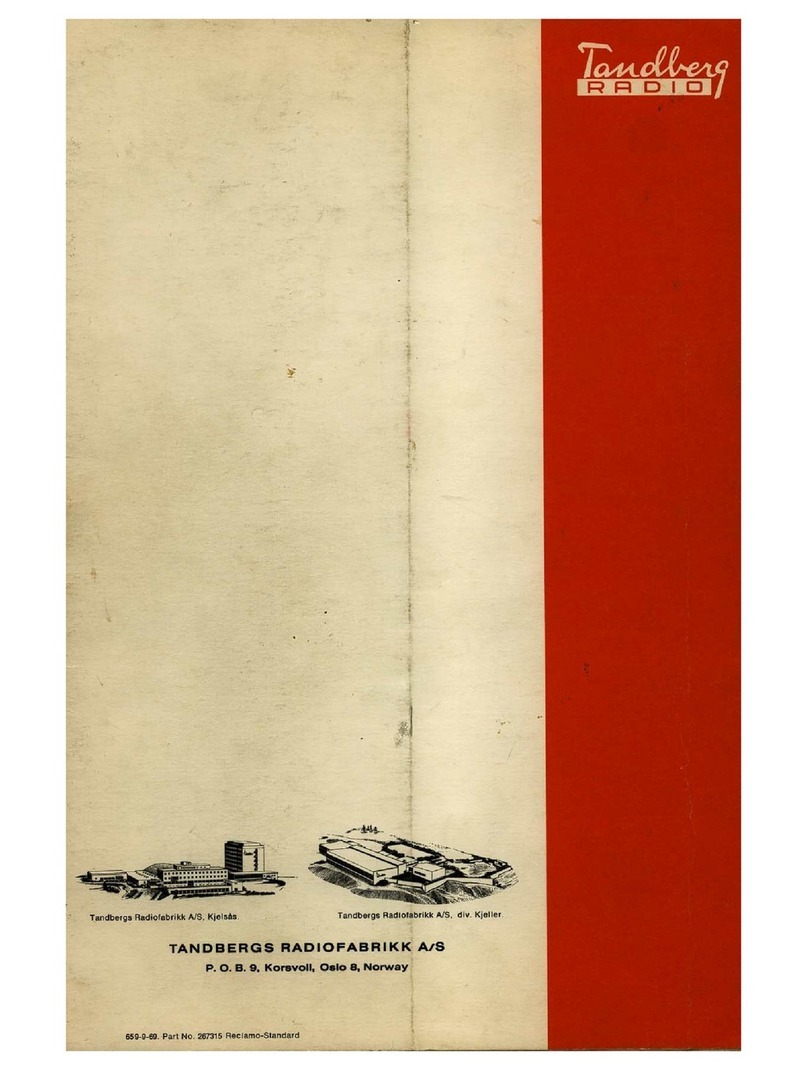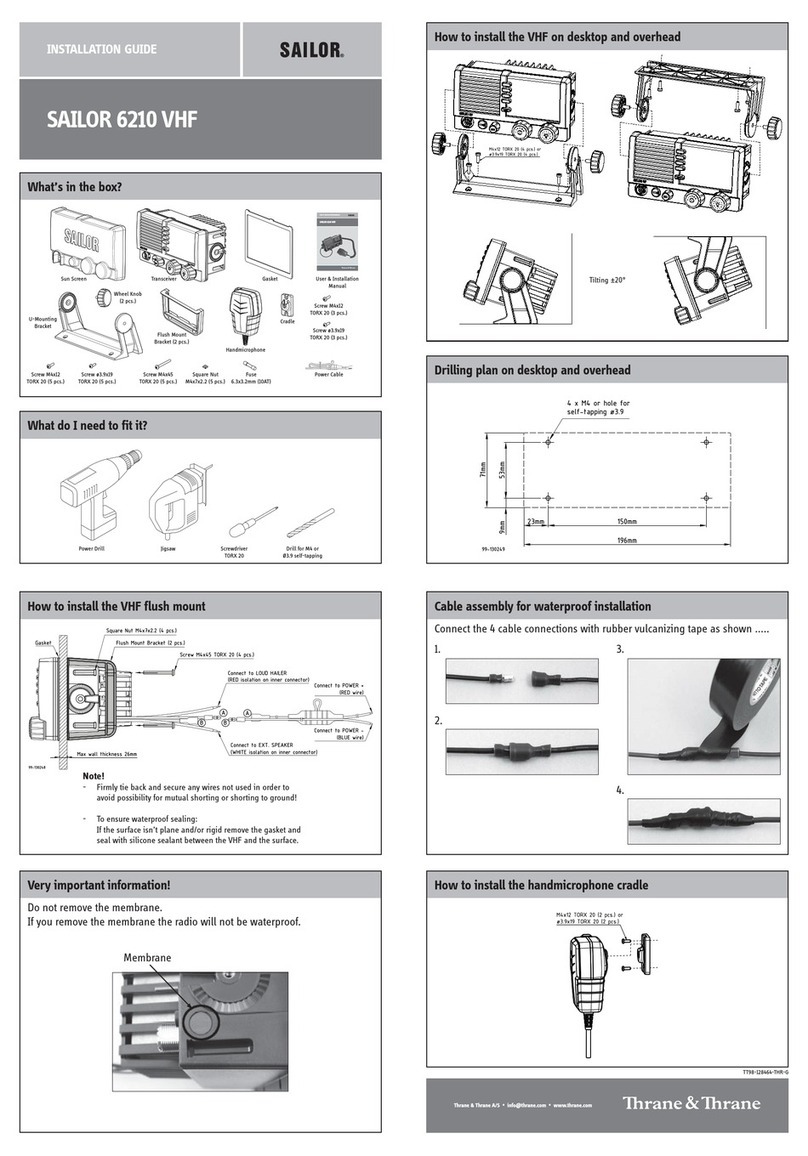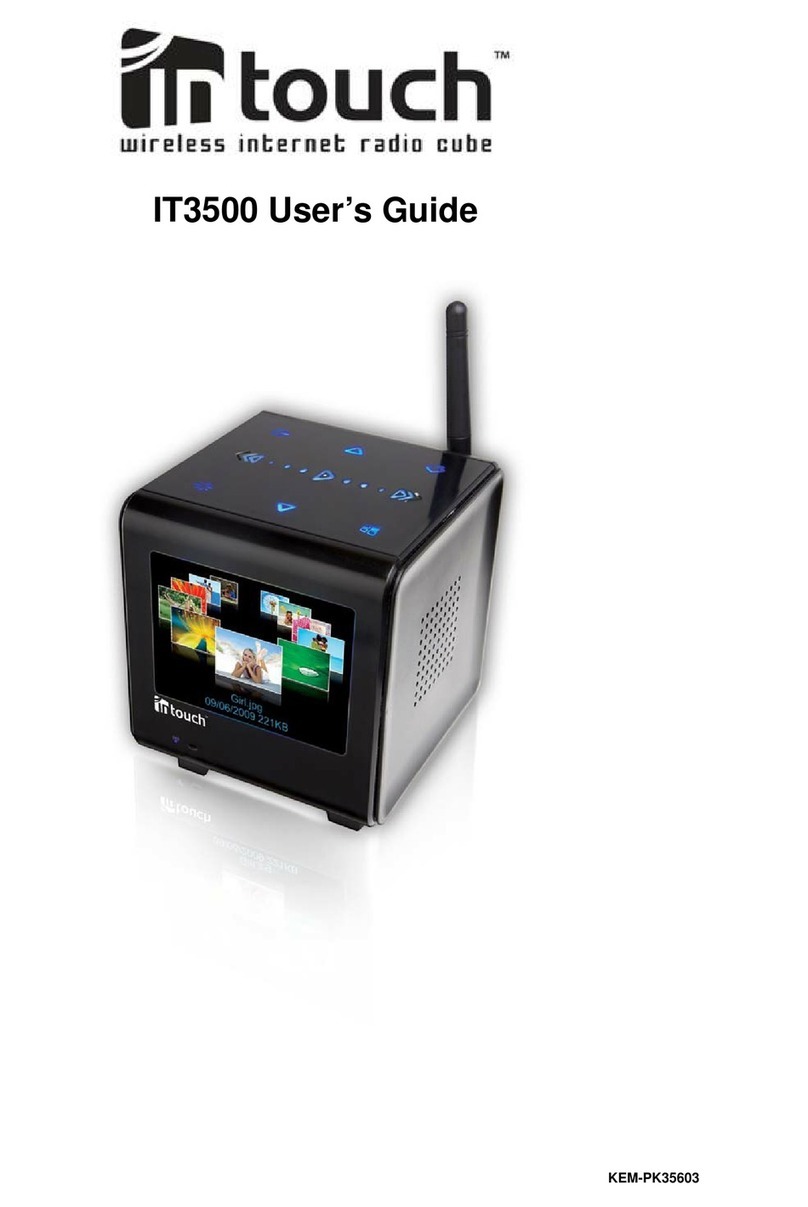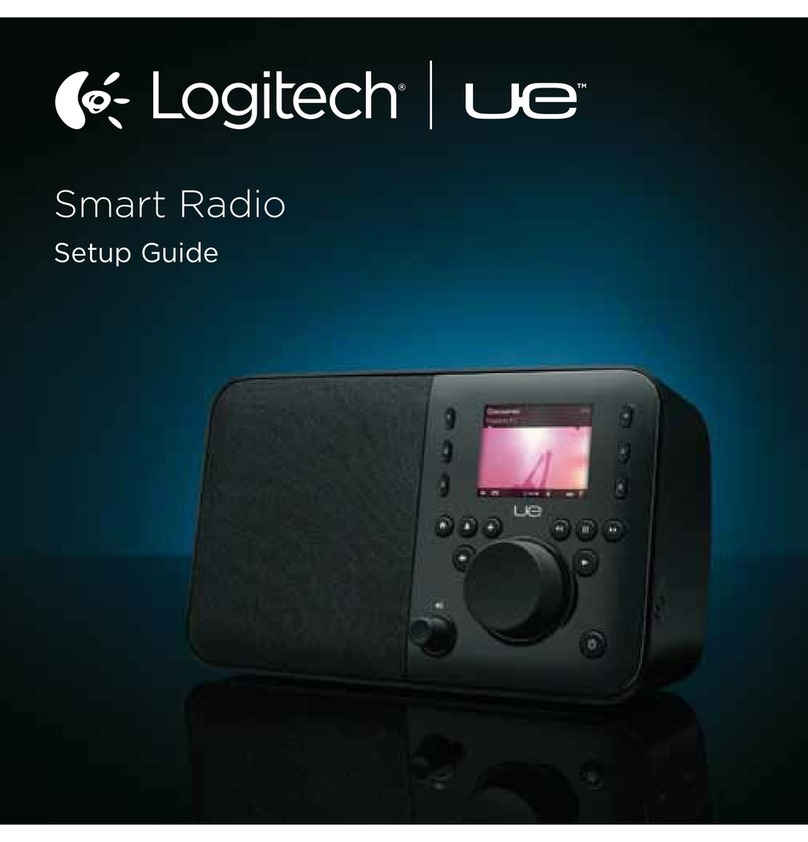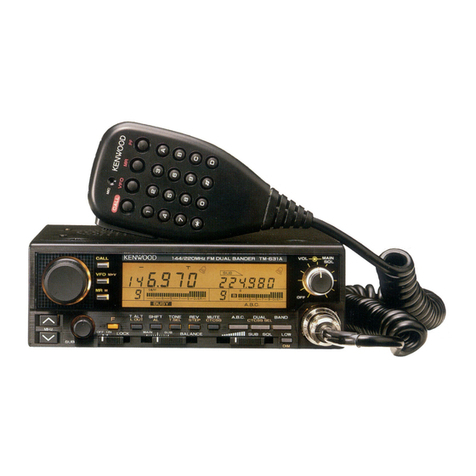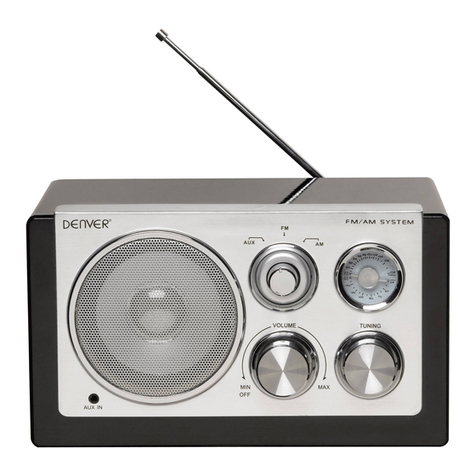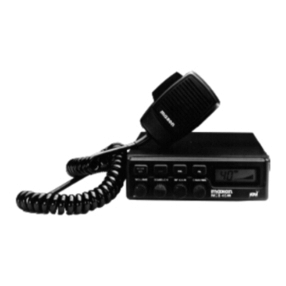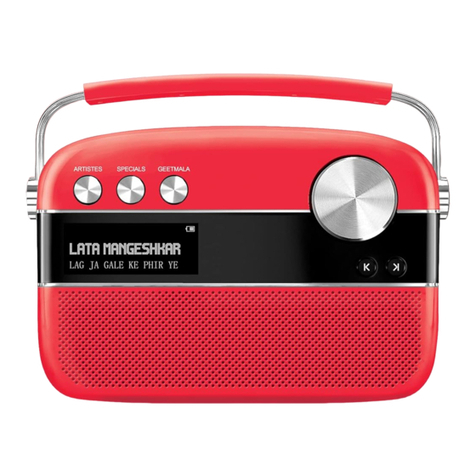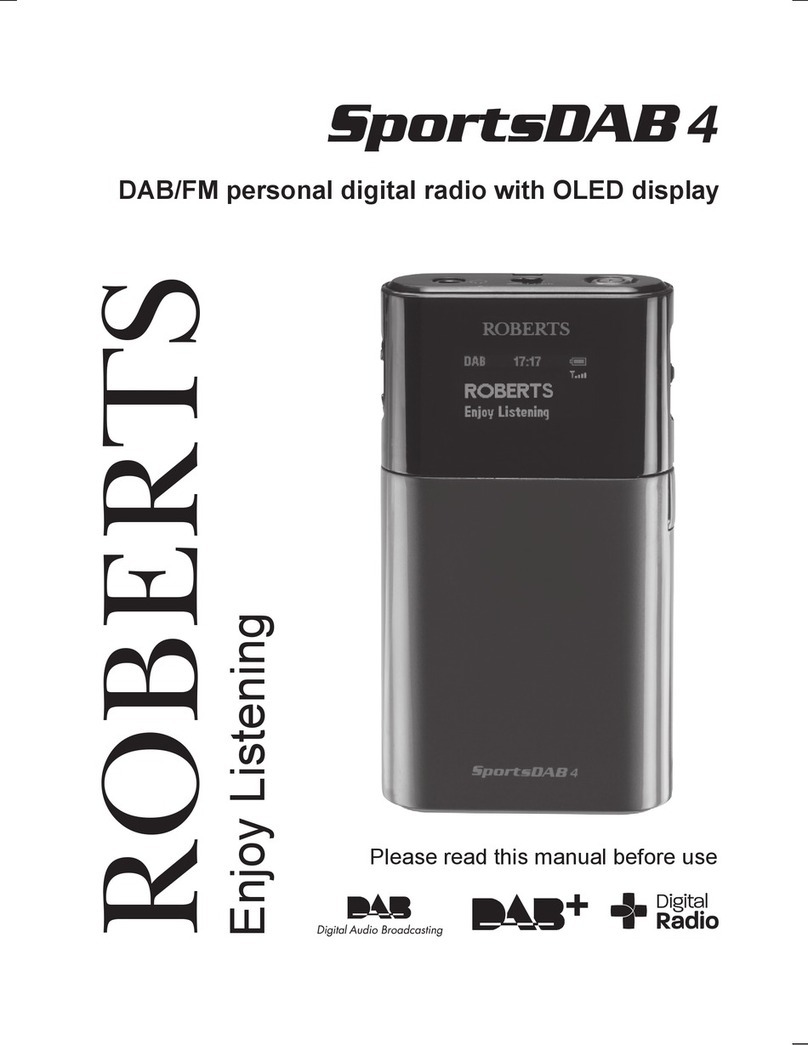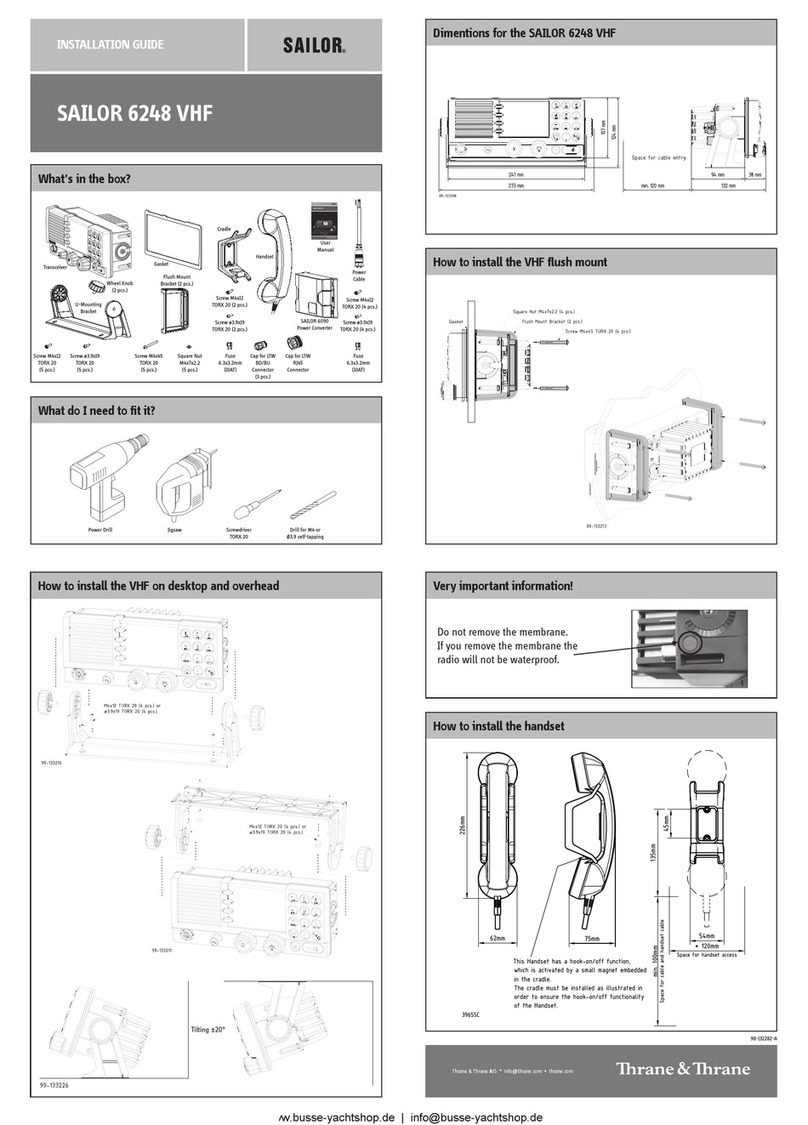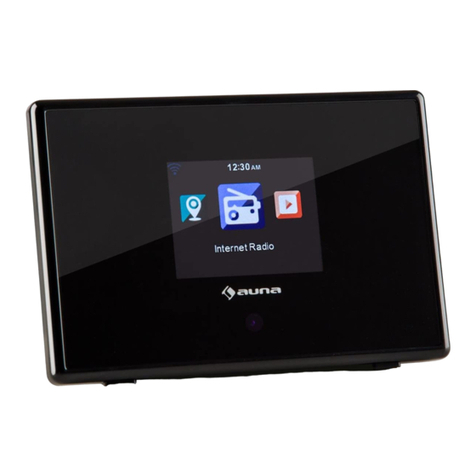TANDBERG Huldra 8 User manual


2
Introduction
This translation contains all pages from the original Norwegian Huldra 8 owner’s manual with an
English translation on the same page. In addition, I have added page 19 with translated figures. The
English text is kept close to the original Norwegian text written in 1965. Text in italics are my own
comments and annotations. I hope you’ll find this translation useful. 26. May 2021. Trond B.
Congratulations on your new Huldra
We hope that the unit will serve you faithfully for many years and bring you joy every day. Huldra
has a lot of features, but if you take it step by step, you will see that it is quite manageable. Huldra
can reproduce programs from 5 different sources:
1. AM radio, i.e., long wave, medium wave, coastal wave and short wave.
2. FM radio.
3. Tape recorder, mono or stereo.
4. Turntable, mono or stereo. A separate 2-channel pre-amplifier with 4 transistors will
ensure full utilization of the power amplifier with the use of magnetic pickup. The pre-amp
has a selector with correction curves for magnetic, ceramic or crystal pickup.
5. From the “listen and talk” function, which enables communication with people in other
rooms.
Huldra 8 is prepared for FM stereo multiplex reception. The main circuit board has dedicated
space and connection points for a decoder for your particular FM stereo system. A separate
indicator light will light up on stereo sound reproduction.
Huldra 8 has 2 transistorized main amplifiers (class B1). Both amplifiers can be used in parallel for
the same program, or independently for two mono programs or one stereo program. The two
amplifiers (channels) have individual volume control. Max. output power is 2 x 10 Watt.
1
It is a class AB amplifier by current classification

3
First, you should get good antennae for AM and FM
At the rear of the unit, you will find sockets for connection of antennae.
Wire antenna. The unit is designed for excellent reception with moderate antenna lengths, but
you will get the optimum result with a 15-20 m long wire antenna. Attach the earth connection to
the nearest cold water pipe using a clamp.
Antenna with shielded cable. If there are strong electrical noise fields around your house, you
may need a shielded cable between your antenna and the radio. Such a system may be a
combined AM and FM antenna system.
FM antenna. The Huldra table model (8-56) has a built-in FM antenna which may be sufficient in
places with good reception. Otherwise, you will need a folded dipole antenna mounted outside of
your house or in your attic, where installation and maintenance may be easier.
The antenna shall be mounted with the loop perpendicular to the direction to the
transmitter/sender. You may need to try different locations and orientations to avoid reflections
and achieve an optimum result.
You may make an indoor antenna from ordinary, unshielded flat antenna cable with two parallel
leads, impedance 240-300 ohm. Make the antenna loop from a cable length of 135 cm. Remove a
short length of isolation on both ends and solder the cores together, as shown on the illustration.
Cut one of the cores at the middle and solder in a feeder cable to the radio receiver. In more
challenging situations, better results can be achieved by using a more expensive antenna with
several elements.
Translation of terms in Fig. 1
LODDES = solder
TIL RADIOAPPARATETS UTTAK FOR FM-ANTENNE = to the radio receiver’s sockets for FM antenna.

4
Operation
Power. The power is turned on when one of the push-buttons (except buttons “Fjern” (Distant)
and “Mono”) is pressed. The power is switched off when button “AV” (Off) is pressed.
Tuning. Selecting one of the AM buttons connects the tuning dial to the AM frequency indicator
while depressing the FM button connects the tuning dial to the FM frequency indicator. Five
favorite markers can be used to remember the frequencies of your favorite radio stations. It is
recommended to first dial in stations manually with button “AFK” (Automatic Frequency Control)
button depressed, fine tune until the “magic eye” is as wide as possible and align the favorite
marker accordingly. It may also be necessary to depress the AFK-button when receiving a weak
station which lies close to a strong station. The automatic frequency control may otherwise be
dominated by the stronger station.
Selectivity. You may get improved selectivity when receiving distant stations by depressing the
Fjern-button. In addition, with this function activated, treble is reduced and, when listening to FM,
the AFK function is disabled.
Volume control. Outer knob controls left channel, inner knob controls right channel.
Tone controls. There are 4 pre-defined sound stages and 2 settings which allows individual
adjustment of bass and treble.
Mørk: Normal bass and reduced treble. This setting helps reduce noise.
Tale: Reduced bass to achieve a more distinct reproduction of speech.

5
Translator’s comments on phrases and terminology used in the original manual
“App.” is short for “Apparat” meaning Apparatus or Device. The main speakers are denoted App. because the
Huldra 8-56 has a speaker pair integrated into the Apparatus, and Tandberg must have decided to use the same
names and markings for 8-55 and 8-56.
“Sep.” means the other/secondary/separate speaker pair.
“LF-Forsterker”means low-frequency amplifier. The name is selected to distinguish it from the tuner high- and
medium frequency (MF) amplifiers. The LF-amp. takes line-level signals from the MF amplifiers, tape recorder or
record player pre-amps and amplifies it to speaker level. The tone controls are implemented in the LF-amp
feedback loops.
“Program” means input source, i.e., radio, tape recorder or turntable
“Klasse B” The manual says the amplifier is class B. The service manual (from which the below illustrations are
taken) actually says that the amplifier power stage is single ended push pull and works in class B. The
terminology has obviously changed. In modern terms, it would be more correct to call the H8 power amp a class
AB quasi-complementary push pull amplifier (with a 30 mA quiescent current.) The 12v 18W lamp seen below
acts as a fuse and lights up if the speaker terminals are shorted.
(Treble)
(Volume, left channel)
(Bass)
(Volume, right channel)
(Tone control)
(Stereo indicator)
(Push buttons)
(Frequency dial)
(Speaker selector)
(Favorite markers)

6
Tone controls (cont’d)
Normal: The entire frequency range is reproduced at even levels
Normal + Bass: Enables physiological bass correction (Loudness)
Variabel Bass og Diskant: Adjust bass and treble independently. Even frequency curve when both
bass and treble are set to 0.
Variabel Bass og Diskant + Bass: Same as above, with the addition of physiological bass
correction (Loudness) as for “Normal + Bass.”
The Speaker selector has 7 settings:
App. 1/Sep. 2: Left audio channel goes to App. (main) speaker pair, right audio channel goes to
Sep. (separate) speaker pair. See also section “Double programs” on page 11.
Sep. 1/App. 2: Left channel goes to the separate speaker pair, right channel goes to the main
speaker pair. See also section “Double programs” on page 11.
Sep: Only the separate speaker pair is in use.
Alle: Both Main and Separate speaker pairs are in use.
App: Only the main speaker pair is in use.

7
Connections
Set the voltage selector according to your mains voltage; 240V, 220V, 150V, 130V or 115V.
Connect antennae, tape recorder and turntable using DIN plugs or phono plugs, where available.
Select correct pick-up type; magnetic (MM), ceramic or crystal type.
Speakers
Huldra 8 is optimized for 4 ohm speakers, but will handle loads from 2-8 ohm with little impact on
output power.
Dipol FM antenna
Wire antenna for AM
Earth cable
Mains voltage
selector
Blue connector
Tape recorder Playback
Red connector
Gray connector
Tape recorder Input
Green connector
Sep spkr Sep. spkr.
Right Left
App spkr App spkr
Right Left
Turntable input
Pick-up type selector

8
(A discussion on serial- and parallel connection of several speakers and the resulting impedance is
not translated, as it is not considered relevant today.)
It is recommended to use twisted speaker cables, especially on left channel when using the
intercom functionality. If not, voltages will be induced in the left speaker cable causing hum when
used as a microphone.
Polarity
When two speakers are close to each other, the polarity must be correct, i.e., the speaker cones
must move in phase. If the polarity is wrong, the cones will move out of phase of each other. This
will have a negative effect when the two speakers are sufficiently close to each other. Bass tones,
in particular, will be attenuated.
Lytt og Tal (Listen and Talk)
With a separate speaker connected to the outlet tagged “Sep. Venstre” (Separate Left), you may
engage in a conversation with people in the room where you have your separate speaker. The Sep.
(separate) and App. (main) speakers will then work both as speakers and microphones. With the
speaker selector in position “Tal” (Talk), left App. (main) speaker will function as a microphone and
in position “Lytt” (Listen,) left Sep. (separate) speaker will work as a microphone. The volume can
be adjusted with the outer volume knob.
“Lytt”and “Tal” can also be used while listening to the radio, tape or records, because “Lytt” and
“Tal” only affects the left channel. Radio, tape or record playing will continue on the right channel.
To listen in on the room with the Sep. (separate) speakers while listening to the radio, tape or
records, keep the speaker selector in “Lytt”. This can be used as a babysitter function. If you switch
the speaker selector to “Tal” (Talk) to give a message to the person in the other room, the other
program will automatically be disabled. The continuous bass- and treble controls are disabled on
the left channel during “Lytt” and “Tal”.

9
Using Tape Recorder and Turntable
Recording radio
When a tape recorder is connected to your Huldra 8, it will always be ready to record from the
radio. All you have to do is to start recording. Since the signal is tapped off before the main
amplifier, the recording is independent of the volume control, tone controls and speaker selector
setting. You may therefore turn the volume all the way down and still record the radio program.
Tape Playback
Press the “Bånd” button. Sound reproduction is in stereo by default. If you prefer monaural
playback, press the “Mono” button. Each amplifier channel can still be controlled individually. The
tone controls will work identically on both channels.
Play Records
Ensure the pick-up selector at the rear is correctly set according to your pick-up type. Press the
“Gram” button. Optionally, press the “Mono” button for monaural playback.
Recording from Turntable
Press the “Gram” button and start recording on the tape deck. The recording can be heard in the
speakers. You may listen to the radio while recording from the turntable to the tape deck by
pressing the button for the preferred wave band and the “Gram” button simultaneously. Set the
speaker selector in position “App. 1/Sep. 2”
Stereo indicator
The stereo indicator lights up when tape or records are played in stereo mode, or during FM
stereo reception, if a FM stereo decoder is fitted (optional).

10
Double Programs (Playing two different sources simultaneously)
You may listen to a radio program in channel 1 while, at the same time, listen to the tape deck or
record player in channel 2. To achieve this, press the button for the preferred wave band and
either “Bånd” for tape deck or “Gram” for record player simultaneously. The outer volume control
controls the radio volume while the inner knob controls the volume of the other program. You
choose which program goes to which room with the speaker selector:
App. 1/Sep. 2: channel 1 (radio) is played in the main speakers and channel 2 (tape deck or
turntable) is played in the separate speakers.
Sep. 1/App. 2: channel 1 (radio) is played in the separate speakers and channel 2 (tape deck or
turntable) is played in the main speakers.

11
Speakers
The speaker is the final and most vital component in all sound reproduction. You should therefore
select speakers carefully. Some of the more important properties of a speaker are frequency
range, efficiency and sound power at low, medium and high frequencies.
Sound radiates from a speaker such that low frequencies propagate evenly in all directions. As the
frequency increases, the sound waves become more focused and high frequencies propagate in a
focused cone.
Tandberg speakers are sealed enclosure designs. A speaker has a has a self-resonant frequency,
just like any oscillating system. The self-resonant frequency determines the lower limit frequency
the speaker can reproduce. The lower the self-resonant frequency, the lower frequencies the
speaker can reproduce. In a sealed enclosure design, the self-resonant frequency increases as the
colume of the enclosure goes down. Conversely, the larger the enclosure, the lower frequencies
the speaker can reproduce.
The self-resonant frequency can also be lowered by increasing the mass of the membrane, which
means more power is required to move it, i.e., the speaker efficiency is reduced. In other words, a
speaker’s ability to reproduce low frequencies can be achieved with a large speaker enclosure and
high efficiency (more sound power) or with a smaller enclosure and low efficiency. The integrated
speakers in Huldra 8-56 and Hi-Fi System 113/106-10 are designed according to the latter
principle. As the Huldra 8 has a power output of 2x10 Watt, you will still have more than sufficient
power for an ordinary sized living room.
One of several properties determining the sound power a speaker can produce, is the length of the
homogeneous magnetic field in which the voice coil moves. Again, bass reproduction is the limiting
factor. To maintain sound power at lower frequencies, the membrane excursions must increase. If
the voice coil moves out of the homogeneous field, harmonic distortion increases significantly.
By making the tweeter membrane small, the sound propagates in a larger cone.

12
Usually, a straight frequency curve can be achieved within a room angle of 60°. In an ordinary
room without too much damping, the higher frequencies will be correctly reproduced in the entire
room if the frequency curve in the amplifier is increased by ca. 10 dB by 10 kHz.
When selecting speakers, it may be wise to take the following into consideration:
An instrument or group of instruments which has its maximum sound effect in the medium
frequencies, will be reproduced with a greater sound power than, e.g., a church organ, which can
produce maximum sound power at 50 Hz. Relative to the level at 1000 Hz, piano music will be ca.
30 dB lower at 50 Hz, and orchestra music ca. 20 dB lower. In an ordinary living room, room
resonance will provide a certain amplification of the lower frequencies.
The sound power from an orchestra drops somewhat in the higher frequencies, typically around
10 dB at 10 kHz. This means that relatively small membranes may be utilized in the tweeter when
the lower frequencies are filtered out.
Hi-Fi System 113/106-10
This speaker is designed according to the principle of low efficiency. A full bass reproduction is
therefore achieved. The system consists of two drivers with a crossover; a woofer for low- and
medium frequencies, and a tweeter for frequencies above 3000 Hz.

13
Dimensions: width 18 cm, height 23 cm and depth 23 cm. Teak enclosure. Internal volume: 6.5
liters. 6.5” woofer: HT 113, 2” tweeter: HT 106. Impedance at 400 Hz: 4 Ohm. Max. continuous
power: 8 watt. Efficiency (frontal radiation only): 0.5%. Resonant frequency: 90 Hz. Frequency
range: 60-16000 Hz.
Hi-Fi System 112-7
This speaker is designed for full power and frequency range from a 10W amplifier. The chassis
consists of 2 coaxially mounted drivers with a crossover; a woofer for low-medium frequencies
and a tweeter for frequencies above 3000 Hz. A low self-resonant frequency and a wide
homogeneous magnetic field ensures excellent bass reproduction.
Dimensions: length 52 cm, height 26 cm and depth 25 cm. Teak enclosure. Internal volume: 25
liters. Driver chassis: HT 112 with tweeter. Woofer: 10”x6”. Tweeter: 2” Impedance at 400 Hz: 3.2
Ohm. Max. continuous power: 8 watt. Efficiency (frontal radiation only): 2.5%. Resonant
frequency: 85 Hz. Frequency range: 60-16000 Hz.
Hi-Fi System 114/116-8
This speaker provides a perfect reproduction of the entire frequency range from 45-16000 Hz with
high efficiency and power up to 20 Watt. A HT 113 tweeter is coaxially mounted in the woofer
chassis. An efficient crossover provides a an accurate frequency division at 3000 Hz. The
homogeneous magnetic field allows bass amplitudes up to 1.5 mm without distortion.
Dimensions: length 70 cm, height 35 cm and depth 28 cm. Teak enclosure. Internal volume: 50
liters. Driver chassis: HT 114 with tweeter. Woofer: 10”. Tweeter: 2.5” Impedance at 400 Hz: 4
Ohm. Max. continuous power: 15 watt. Efficiency (frontal radiation only): 5%. Resonant frequency:
65 Hz. Frequency range: 45-16000 Hz.

14
Technical Data
5 vacuum tubes: ECH81, EAF 801, EF 89, ECC 85, EM 87
20 transistors: 1 off SE 1002, 5 off U 3962 (SE 4010), 4 off SE 4001, 2 off SE 6001, 2 off AC 127, 2
off AC 128 (AC 152) and 4 off AS 150 (AD 149)
6 diodes: 2 off 1N 542 (AA 113), 2 off 1S 920, 1 off OA 81 and 1 off BA 124.
3 rectifiers: 1 off B40 C 2200, 1 off BY 112 and 1 off 2,8 ST. 1.
Printed circuit boards ensures improved stability and reliability.
5 Wave bands:
Long wave: 150 - 350 kHz (2000 - 857 m)
Medium wave: 510 - 1610 kHz (590 - 186 m)
Coastal wave: 1.6 –5.9 MHz (187 –50.9 m)
Short wave: 5.9 - 23 kHz (50.9 - 13 m)
FM band: 87.5 –108 MHz (3.43 –2.78 m)

15
FM Multiplexing: Huldra 8 is prepared for FM stereo reception. There is dedicated space for a
connector for an FM stereo decoder. The stereo indicator lights up on stereo reception.
Duplex dial: There are 2 frequency indicators; one for FM and another for AM. The frequency dial
is automatically switched to the selected wave band.
FM Tuner: 3 tuned circuits with bandpass filters in the high frequency stage. The FM amplifier has
4 stages with bandpass filter and discriminator.
Favorite station markers: 5 moving markers to indicate your favorite stations.
Automatic FM fine tuning: When dialling in a station, the AFK function will automatically fine tune
the frequency. This function can be switched off.
Interference filter: 9 kHz filter for AM
Selectivity selection for AM local or distant stations.
Tone controls: Choose between pre-defined tone curves and variable bass and treble control with
graded scales. The tone selector has 6 positions, of which 4 are pre-defined tone curves: “Mørk”
(Dark), “Tale”(Speech), “Normal”and “Normal+Bass”. In these 4 positions, the dedicated bass and
treble control dials are out of function. The two last positions are for individual variable bass and
treble adjustment using the dedicated bass and treble controls. In position “Variabel 2”, the bass
increases with reducing volume. This is called physiological bass compensation (Loudness.)

16
Amplifiers: Huldra 8 has 2 transistorized power amplifiers with individual volume adjustment. The
two amplifiers can play one source in mono or stereo or two separate sources in mono.
Frequency range: 20-20000 Hz (-3dB at 30 and 17000 Hz)
Output power: 2 x 10 Watt
Pre-amplifier for magnetic pick-up: A separate pre-amp with 2 transistors per channel enables
max. output from the power amplifiers from a magnetic pick-up. The pre-amp has a selector with
correction curves for magnetic- ceramic and crystal pick-ups.
Connections: Huldra 8 has 5-pin DIN connectors for connection of tape deck and turntable. Some
units have RCA Phono connectors in addition. There is a diode output for recording radio. Each
amplifier has 2 sets of 2-pin DIN speaker connections for APP (main) and SEP (separate) speakers.
Some units have banana sockets in addition to the 2-pin DIN plugs. The optimal speaker load is 4
Ohms per channel.
10 push buttons for selection of wave band, tape recorder, turntable, Mono/Stereo, AM
selectivity and AFC for FM.

17
The speaker selector has three functions with a total of 7 positions.
A. Choice of speaker pairs; main speakers, separate speakers or both.
B. Choice of source for the main speakers and another source for the separate speakers
C. “Talk and Listen” for intercom functionality
Double Programs: One amplifier is connected to the tuner and the other i connected to tape deck
or turntable. Choose which source plays in which speaker pair. “Listen and Talk” can be in the
“Listen” position (babysitter function) while you listen to the radio, a tape or a record. Switching to
position “Talk” will automatically disconnect the other source.
Power supply: Easy change between 115, 130, 150, 220 and 240 Volts, 50/60 Hz AC.
Power usage: 55 W at normal power output, 85 W at full output power (2x10W).

18
Block diagram. Phrase translations:
Strekk-antenne
Wire antenna
Kanal
Channel
MF-Forsterkere
MF-Amplifiers
Tangent velger
Push buttons
Grammofon
Turntable
Høyre
Right
Dynamisk
Dynamic (here:
magnetic)
Venstre
Left
Keramisk
Ceramic
Sep.
Separate
Krystall
Crystal
App.
Apparat (Main)
Båndopptaker
inngang
Tape desk input
Høytt.
Speaker
Båndopptaker utgang
Tape desk output
Kraftforsyning
Power supply

19
This page is not in the original manual. It has been added in order to translate the illustrations in the
original manual:
Harmonic distortion curves for the main amplifiers. The curves
show 3 frequencies and 3 speaker equivalents. Voltage level on
tape recorder input: 200 mV.
Frequency curves for the pre-defined sound stages of the tone
controller. Position NORMAL + BASS provides physiological bass
correction, i.e., the bass level increases as the sound volume
decreases (Loudness). Curves for 3 volume levels are shown.
Frequency curves for the individual bass and treble controls and
the tone controller in position “VARIABEL BASS og DISKANT”
Curves for min. and max, as well as a few intermediate settings
are shown.
LEFT CHANNEL RIGHT CHANNEL
SEP. SPKR SEP. SPKR.
APP. SPKR. APP. SPKR.
RADIO PROGRAM TAPE/TURNTABLE PROGRAM
CHANNEL 1 CHANNEL 2
MAIN 1/SEP. 2
SEP. 1/MAIN2
TONE CONTROL IN POSITION «NORMAL»
SELECTIVITY SET TO “FJERN” (DISTANT)
Frequency curves for AM reception with tone control in setting
NORMAL and both selectivity settings.
NORMAL + BASS
BASE CURVE FOR MAIN AMP.
NORMAL, DARK
NORMAL, SPEECH
SPEECH DARK
Normal living room level Powerful living room level
Medium Deep Medium Deep
Small living room (orchestra) (organ) (orchestra) (organ)
Large living room
Small hall
Large hall
SPEAKER EQUIVALENT
Bass in pos. 10 (max) Treble in pos 10 (max)
Bass in pos. 0
Treble in pos. 0
Bass in pos. -10 (min)
Treble in pos. -10 (min)

20
Table of contents
Other TANDBERG Radio manuals
